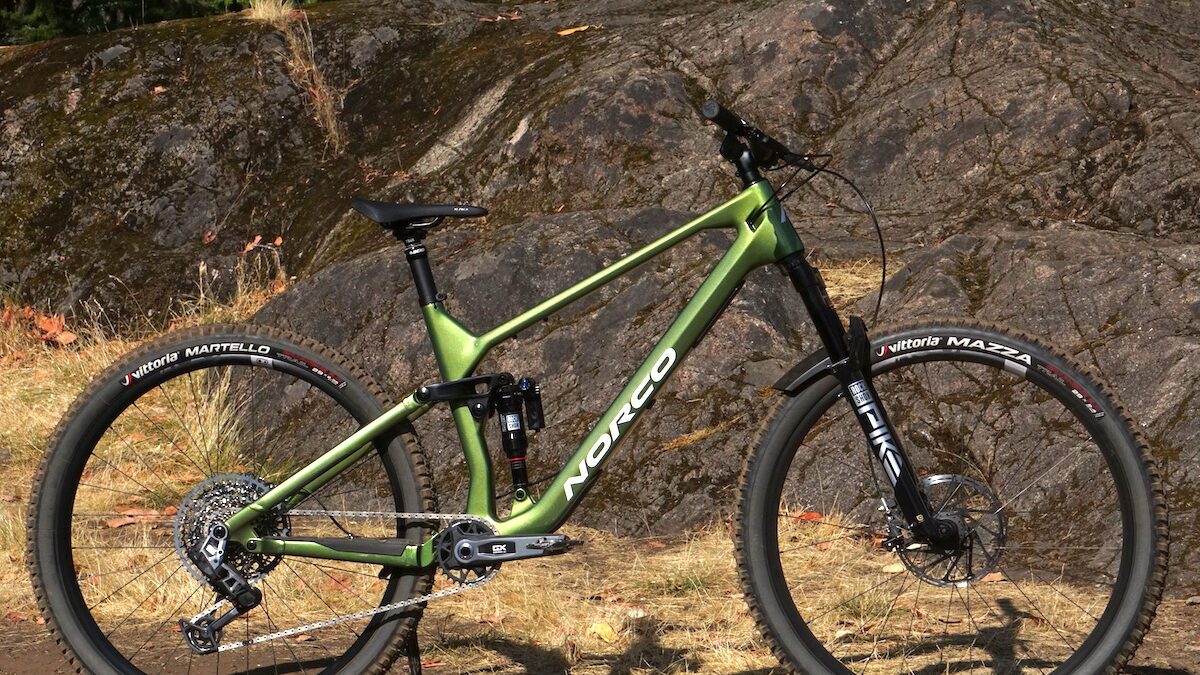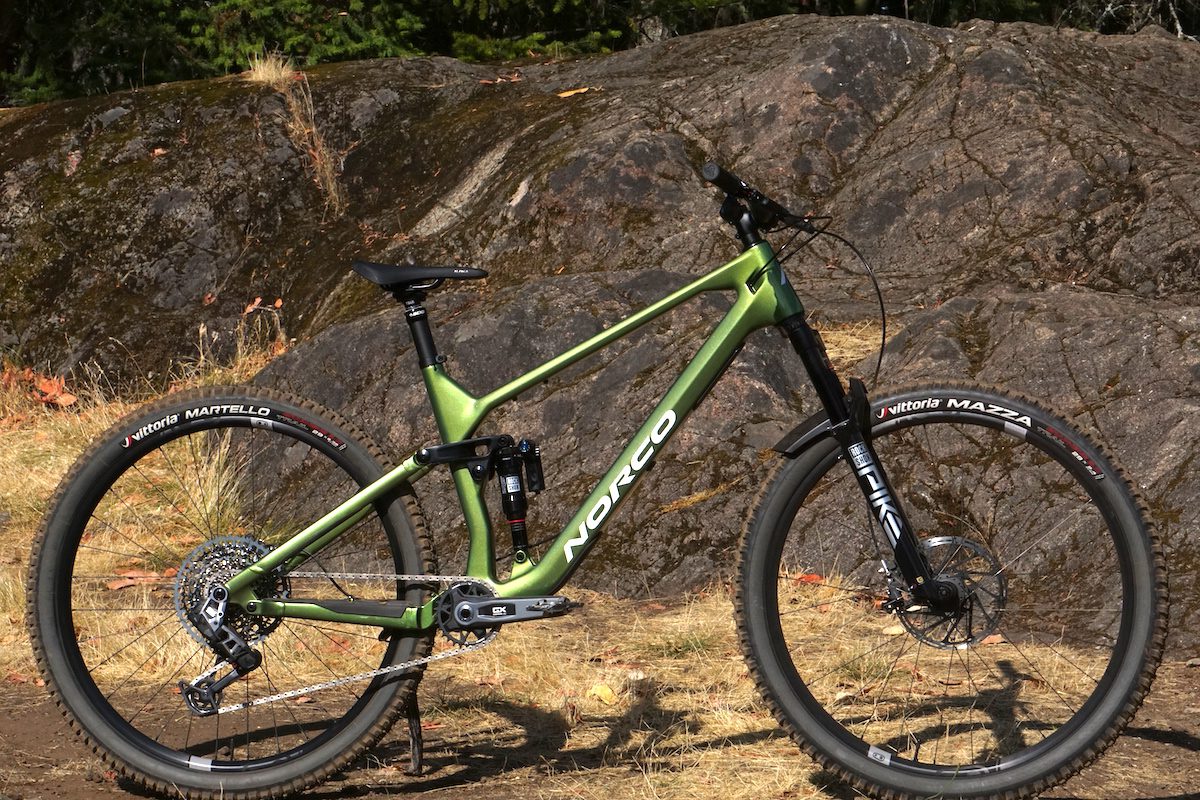First Impressions: Norco Fluid FS gets carbon fibre frame
New frame shaves weight, keeps the same core idea as alloy model

After a very warm reception for the Fluid Alloy last year, Norco is bringing the short travel trail bike back with an upgrade to a carbon fiber frame.
Still not an Optic. Really
One of the main points distinguishing the alloy Fluid FS from the existing Optic was its price and alloy frame. Norco packed a whole lot of performance for the cost of the Fluid. There was also a slightly longer shock, aimed at a slightly more forgiving and well-rounded ride than the Optic. So, now that Fluid comes in a carbon fibre frame, what’s the difference between the Fluid Carbon and the Optic?
Not much, sure, and Norco hints at that with a wink in the Fluid Carbon’s on-point “Lighten Up” ad campaign. But there are differences. The frame is lighter, too. 600 grams lighter than the alloy Fluid, yes. But it is also 150 grams lighter than the Optic. The Fluid Carbon also get the full Ride Aligned geometry treatment, adding size-specific seat tube angles to size-specific rear centre (whereas the Optic only changes rear centre lengths between sizes).
That, and the new Fluid Carbon stills has a longer-stroke shock than the Optic does. Like on the alloy version, this is designed to give the Fluid a more well-rounded ride than the Optic. It’s easier to get the shock moving and doesn’t require as much rider input to get the most out of bikes as the Optic does. The Fluid also has a slightly longer reach for confidence at speed. Basically, it’s a bit easier to ride than the Optic, though Norco is quick to say its also very capable if you’re looking to push yourself on rowdier trails.
What’s new: Norco Fluid FS Carbon
The main difference between the alloy Fluid and Fluid Carbon is, of course, the carbon fibre front triangle. But the material isn’t the only change.
Let’s start with the frame though. Why not just make a Fluid alloy with a lighter parts kit? Well, Norco argues that the front triangle is the most cost-effective way to cut weight and has the most effect. It’s the best weight-per-dollar and makes changes in the right place. Norco engineers can make the frame very durable as they are making it lighter by using the more expensive material. In contrast, going to lighter wheels would either compromise durability or cost way more than the difference in price between the alloy Fluid and the new models. As mentioned above, Norco was able to make the frame 150 grams lighter than the carbon fiber Optic frame. Like many Norco frames, the rear triangle remains made of aluminum.
Moving to carbon fiber also allows Norco to add small refinements to the Fluid frame. This includes a bash guard and better cable management that results in a quieter bike on trail. There are also bearing mounts in the upper pivot, which were too cost prohibitive to add to the alloy frame but fit in with the carbon fibre price range.
Norco does lose the XXL frame option in the move to carbon fiber, though. While Norco says they were happy with how many people were happy to see an XXL in the alloy frame, making an extra jig is much cheaper than making another mold for a carbon fibre frame and keeping the XXL isn’t cost-effective at this point.
What’s the same?
While the frame material changes, the core idea of the Fluid remains the same. It’s a 130-mm rear travel frame with 140mm forks and 29″ wheels, designed for all-around trail riding. Ride Aligned geometry aims to make each size feel the same on trail by keeping the rider centered on the bike, using size-specific rear-centres and seat angles. More brands are catching onto the importance of size-specific changes like this, but Norco is one of the few bringing this to a wide range of price points, like the alloy Fluid FS. The Ride Aligned app also gives suggested suspension and tire settings based on height, weight, and self-evaluated skill level and riding style.
There’s also still room for long-travel dropper posts, and a 34.9mm diameter post width is used to ensure reliability at those lengths. Size small frames start with a 150mm dropper, while Medium get 170-mm posts and Large and XL frames get a full, 200mm-drop post out of the box.
First Impressions: Norco Fluid FS Carbon
After really enjoying the Fluid FS in its original alloy version, we were happy to get a Fluid FS Carbon in for testing. It’s early days but, as you’d expect, it’s a little bit lighter and a little bit more fun than the green machine we so enjoyed last year. The carbon frame isn’t just a little easier to push up hills. It also accelerates quicker out of corners, is easier to move around on the trail and carries speed better up little rises in rolling trails.
These are all traits that make a trail bike like the Fluid FS more fun to ride. With the Fluid Carbon range including the $5,200 C3, just $200 more than the Fluid FS A1, the performace-for-value that made the alloy Fluid stand out from the herd is still there to be found. The C1 adds a bunch of high-end bits, like wireless direct-mount drivetrain and nicer suspension, of course. But there is still a very value-focused option in the line.
The carbon fibre frame does bring the Fluid FS C into significant overlap with the Optic, to be sure. There are differences between the two, though. Are these “grey lines”? Sure. But that doesn’t mean either is a “bad” bike, they just play to small changes in rider preferences. The Fluid Carbon is a great bike, like the Fluid alloy is. And the Optic, Revolver 120 and Sight are all good bikes, too. It does make Norco’s line a little, uh, comprehensive at the moment. That may change in the future . But, for now, if Norco want to offer all those bikes, that’s the brand’s call. It means Norco fans have all kinds of choices to get exactly what they want out of the box, instead of having to customize their ride. That’s a hard thing to complain about, from a rider’s perspective.

Pricing and availability: Norco Fluid FS Carbon
Norco offers the Fluid FS Carbon in three price points, plus a frame-only option that is only available in Canada. Each build comes in two frame colour options.
The top-end Fluid FS C1 rides on a RockShox Pike Ultimate (140mm) and a RockShox Super Delux Ultimate (210mmx50mm) custom tuned for the Fluid FS. It gets SRAM’s brand-new GX Transmission direct-mount wireless electronic drivetrain and CrankBrother’s Synthesis Enduro Alloy wheelset with a Vittoria Mazza 2.4″/Martello 2.5″ tire combo. SRAM G2 RSC brakes slow the Fluid down.
The C2 moves to RockShox Select+ level suspension, SRAM mechanical GX Eagle 12-speed drivetrain, G2 RS brakes and WTB ST Light alloy wheels. The C3 uses RockShox Select suspension and a mix of SRAM SX and NX Eagle 12-speed drivetrain, SRAM DB8 brakes and WTB ST wheels. Both C2 and C3 use the same Vittoria Mazza/Martello tires as the C1.
Norco Fluid FS Carbon
- Fluid FS C1: $8,000 (USD 6,000)
- Fluid FS C2: $6,200 (USD 5,000)
- Fluid FS C3: $5,200 (USD 4,100)
- Fluid FS C Framekit: $3,300 (Only available in Canada.)





